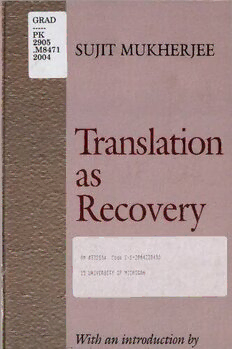
Translation as Recovery PDF
Preview Translation as Recovery
SUJIT MUKHERJEE Translation as Recovery With an introduction by m • t* TRANSLATION AS RECOVERY Sujit Mukherjee Translation as Recovery Edited by Meenakshi Mukherjee With an Introduction by Harish Trivedi Pencraft International Delhi-110052 Published by Anurag Jain for Z .ÏO 5 Pencraft International Sales Office: 4262/3, Ansari Raod, Darya Ganj, New Delhi-110002 Head Office: B-l/41, Ashok Vihar II Delhi-110052 Phones : 23277084, 27443784, 27120156 e-mail : [email protected] Fax: 27443784 Copyright© Reserved with the Editor, Meenakshi Mukherjee Copyright © All rights reserved. No part of this publication may be reproduced in any form without the written permission of the Editor, Meenakshi Mukherjee. Translation Studies First Edition : 2004 ISBN 81-85753-63-6 Laser typeset at Suneha Computer Systems WZ-526, Nangal Raya, New Delhi-110046 Printed at D.K. Fine Art Press (P) Ltd. A-6, Nimri Commercial Centre, Ashok Vihar IV, Delhi-52 ¿rr«J LC'Qt Ik* Editor’s Preface Sujit Mukherjee left on his table a file marked Translation as Recovery which contained some of his published essays on translation and several unpublished ones. There was also a tentative Table of Contents from which I know that he was planning to write a few more, among them the title essay which was probably going to explain why he chose this name for his proposed book. I would not have ventured to edit this volume but for the encouragement and support of two friends, Harish Trivedi and S.P. Jain. Harish came to Hyderabad in early 2003, soon after Sujit’s death, and rummaged through his papers to assure me that there was enough material for a book here. He and Sujit have been close associates in their work on translation ever since 1981 when Sujit found out that this young lecturer from St. Stephens College was the anonymous publisher’s reviewer for Translation as Discovery. Harish’s long report on his manuscript, Sujit always said, was the best piece of constructive criticism he ever received. These two friends of unequal age have exchanged views on translation (and other matters) for more than two decades, in conversation and through correspondence, and it is most appropriate that Sujit’s last book should have an Introduction by Harish. Even before the manuscript for Translation as Recovery was finalised Sujit had talked to S.P. Jain about it and offered to send him a Table of Contents to help him to decide whether Pencraft would be interested in publishing it. Dr. Jain with his unfailing courtesy and generosity assured him that even without looking at the contents he was certain he would want to publish the book. I happen to know all this because I was sending and receiving these e-mail messages on Sujit’s behalf. He refused to use the computer and avoided communicating through e-mail as far as possible. The manuscripts of most of his books were prepared on his old Olivetti, precious to him because it was a gift from his daughter Rukmini who bought it out of her scholarship money while a student in England. I have tried to sort out as far as possible the tangled material of various kinds that make up this book, some published essays, some handwritten on loose sheets, some typed papers presented at various conferences with many corrections scribbled in the margins and insertions in small pieces of paper stapled here and there. Some of the blanks in the end notes had to be filled in. If I have made mistakes in the process of tidying up, I take the blame for those. Also, adding the book reviews as Section III of the volume was initially my idea, subsequently endorsed by Harish and S.P. Jain. I do not know if Sujit would have approved of this. For permission to reprint the reviews and the published papers I thank the editors of the journals/volumes where they first appeared. I am grateful also to Subashree Krishnaswamy of Chennai and A Dinakar, Librarian, SCILET, Madurai for help in locating the source of the published reviews. I did not know the story behind the title Translation as Recovery until our friend Ashok Kelkar wrote to me about it. Kelkar had published an essay with this title in a feschtshrift volume for Lothar Lutze in 1994. His essay mentioned that title ‘Translation as Recovery’ “of course alludes to Sujit Mukherjee’s Translation as Discovery (1981)”. Kelkar’s letter says “When Sujit saw my artticle he wrote to me saying: while your title merely alludes to mine, I’m going to pinch yours straight away for my next book, it’s too good not to.” That ‘next book’ is being published now, posthumously and with some trepidation on my part. Sujit’s standards were exacting both as a writer and as a publisher’s editor. I will never know if my attempt at editing his manuscript would have passed his scrutiny. Hyderabad Meenakshi Mukherjee January 14, 2004 Contents Editor’s Preface Meenakshi Mukherjee 5 Introduction Harish Trivedi 11 SECTION I ANUVAD VIVAD - 1. Re-slating Translation 21 2. The Craft not Sullen Art of Translation 33 3. Transcreating Translation 43 4. Publish and Perish 53 5. The Absent Traveller: A Classical Text in Translation 63 6. Unfinished Song, Incomplete Road: Text, Film and Translation 73 SECTION II RABINDRANATH IN ENGLISH 7. Urvashi: When She Danced 83 8. Twice-Told Tales 99 9. Rabindranath into Tagore: The Translated Poet 113 10. The English Rabindranath 124 SECTION III REVIEWING TRANSLATION 11. Terminology and Practice 139 12. Third World Texts in First World Academy 144 13. Bankim in Translation 148 14. Penguin Reprints 152 IS. Operation? Mahasweta 16. Politics of a Love Story 165 17. Unslating the Translator: A Review of Reviews 171 SECTION IV TRANSLATION AS RECOVERY: AN EXERCISE 18. History of India as Revealed In a Dream by Bhudeb Mukhopadhyay, 1862 (Translated into English by Sujit Mukherjee) 177 Index 205
